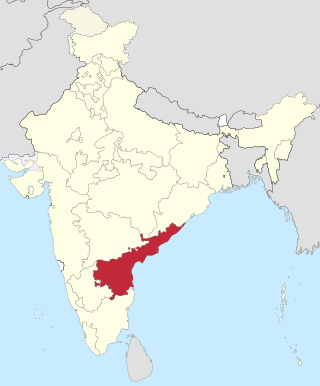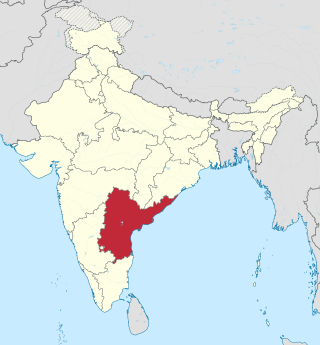
Andhra Pradesh is a state in the southern coastal region of India. It is the seventh-largest state with an area of 162,970 km2 (62,920 sq mi) and the tenth-most populous state with 49,577,103 inhabitants. It shares borders with Chhattisgarh, Odisha, Karnataka, Tamil Nadu, Telangana and the Bay of Bengal. It has the second-longest coastline in India at about 974 km (605 mi). After existence as Andhra State and unified Andhra Pradesh, the state took its present form on 2 June 2014, when the new state of Telangana was formed through bifurcation. Amaravati is the capital of the state, with the largest city being Visakhapatnam. Water sharing disputes and asset division with Telangana are not yet resolved. Telugu, one of the classical languages of India used by the majority of people, is the first official language.

India is a federal union comprising 28 states and 8 union territories, for a total of 36 entities. The states and union territories are further subdivided into districts and smaller administrative divisions.

South India, also known as Peninsular India, is the southern part of the Deccan Peninsula in India encompassing the states of Andhra Pradesh, Karnataka, Kerala, Tamil Nadu and Telangana as well as the union territories of Lakshadweep and Puducherry, occupying 19.31% of India's area and 20% of India's population. It is bound by the Bay of Bengal in the east, the Arabian Sea in the west and the Indian Ocean in the south. The geography of the region is diverse, with two mountain ranges, the Western and Eastern Ghats, bordering the plateau heartland. The Godavari, Krishna, Kaveri, Tungabhadra and Vaigai rivers are important non-perennial sources of water. Chennai, Bangalore, Hyderabad, Coimbatore and Kochi are the largest urban areas in the region.

Telangana is a state in India situated in the southern part of the Indian peninsula on the high Deccan Plateau. It is the eleventh-largest state and the twelfth-most populated state in India as per the 2011 census. On 2 June 2014, the area was separated from the northwestern part of United Andhra Pradesh as the newly formed state of Telangana, with Hyderabad as its capital.

Andhra State was a state in India created in 1953 from the Telugu-speaking northern districts of Madras State. The state was made up of this two distinct cultural regions – Rayalaseema and Coastal Andhra. Andhra State did not include all Telugu-speaking areas, as it excluded some in Hyderabad State. Under the State Reorganisation Act of 1956, Andhra State was merged with the Telugu-speaking regions of Hyderabad State to form Andhra Pradesh.

Khammam district is a district in the eastern region of the Indian state of Telangana. The city of Khammam is the district headquarters. The district shares boundaries with Suryapet, Mahabubabad, Bhadradri districts and with Eluru and NTR districts.

Ranga Reddy district is a district in the Indian state of Telangana. The district headquarters is located at Kongara Kalan Village, Ibrahimpatnam Mandal,. The district was named after the former deputy chief minister of the United Andhra Pradesh, K. V. Ranga Reddy. The district shares boundaries with Nalgonda, Yadadri Bhuvanagiri, Hyderabad, Medchal–Malkajgiri, Nagarkurnool, Mahabubnagar, Sangareddy and Vikarabad districts.
South Zone Culture Centre (SZCC), an autonomous organisation of Ministry of Culture (India) Govt of India, is one of the seven Zonal Cultural Centres established by Indian Government in 1986 to preserve and promote traditional cultural heritage in

Andhra Pradesh State Road Transport Corporation, officially Andhra Pradesh Raastra Roadu Ravaana Samstha, is the state-owned road transport corporation in the Indian state of Andhra Pradesh. Its headquarters is located at NTR Administrative Block of RTC House in Pandit Nehru bus station of Vijayawada. Many other Indian metro towns in Telangana, Tamil Nadu, Karnataka, Odisha, Yanam, Kerala, Maharashtra and Chhattisgarh are also linked with the APSRTC services.

The following outline is provided as an overview of, and topical guide to, India:
The Cultural Zones of India are seven overlapping zones defined by the Ministry of Culture of the Government of India to promote and preserve the cultural heritage of various regions of India. Each of these zones has been provided with a zonal centre. Most zonal centres were announced by the then-Prime Minister of India, Rajiv Gandhi, in 1985 and formally began functioning in the 1986–87 period. Their stated goal is "to strengthen the ancient roots of Indian culture and evolve and enrich composite national culture".

A Divisional Commissioner, also known as Commissioner of division, is an Indian Administrative Service officer who serves as the administrator of a division of a state in India. The post is referred to as regional commissioner in Karnataka and as revenue divisional commissioner in Odisha.
A sub-division is an administrative division of a district in India. In some states(Andhra Pradesh, Telangana, Tamil Nadu, Kerala) they are called Revenue Divisions. It is headed by a sub-divisional magistrate. In some states, the post is designated as Revenue Divisional Officer (RDO) or Sub-Divisional Officer (Civil). A district may have multiple sub-divisions, and each of those sub-divisions may contain multiple sub-districts and municipalities. For example, in West Bengal, the Murshidabad district contains five sub-divisions (mahakumas)

Southern Zonal Council is a zonal council that comprises the states and union territories of Andhra Pradesh, Karnataka, Kerala, Puducherry, Tamil Nadu, and Telangana
The South-Central Zone Cultural, Nagpur or SCZCC one of the seven Zonal Cultural Centres in India was established in 1986 with its headquarters at Nagpur. It comprises the linguistically different states of Andhra Pradesh, Karnataka, Madhya Pradesh, Telangana, Chhattisgarh, Goa and Maharashtra. Each of these States has rich traditions of folk, tribal, fine arts and crafts. The Centre strives through its various activities to enrich, promote and strengthen these traditions. The centre is working under the control of Ministry of Culture, Government of India. The Governor of Maharashtra is the chairman of this centre.

Andhra Pradesh, retrospectively referred to as United Andhra Pradesh, Undivided Andhra Pradesh or Ummadi Andhra Pradesh, was a state in India formed by States Reorganisation Act, 1956 with Hyderabad as its capital and was reorganised by Andhra Pradesh Reorganisation Act, 2014. The state was made up of three distinct cultural regions of Telangana, Rayalaseema, and Coastal Andhra. Before the 1956 reorganisation, Telangana had been part of Hyderabad State ruled by Nizam of Hyderabad, whereas Rayalaseema and Coastal Andhra had been part of Andhra State, formerly a part of Madras Presidency ruled by British India.
























